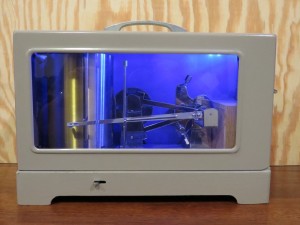Transcript available below.
Tag: hardware
Invasive species, overfishing, ocean plastics, wildlife tracking, and measuring ecosystem services, are some of the most daunting challenges in conservation.While these challenges require a combination of social, commercial, and regulatory cooperation to address, they can also be tackled through technological innovation, which can bypass some of the largest hurdles to implementing practical, timely solutions.
On April 21, 2017, 18 teams of conservationists, technologists, makers, and hardware hackers will gather in Washington DC and tackle five conservation challenges selected by a panel of experts at the Make for the Planet, part of the Smithsonian’s Earth Optimism Summit. Over three days, teams will work to develop prototypes, strategic frameworks, and model systems that address specific issues within the broader challenge prompt of terrestrial species invasion, overfishing, ocean plastics, wildlife tracking, and ecosystem services.
Read More “Make for the Planet with Conservation X Labs and the Earth Optimism Summit!” »
I wrote this story a couple of years ago and have been trying to find a home for it ever since. As the issue of proprietary software’s relationship to agricultural technology is back in the news, I figure it’s time to stop shopping this short science fiction story around and put it in front of a real audience. For some real-world background reading, see:
- Why American Farmers Are Hacking Their Tractors With Ukrainian Firmware.
- Hacking the Tractor: what the future of farming means for open science.
- New High-Tech Farm Equipment Is a Nightmare for Farmers.
- We Can’t Let John Deere Destroy the Very Idea of Ownership.
DEAR JOHN.
It started with the tractor. Or, rather, it stopped with the tractor. John Willis climbed down from the cabin of his dead machine and removed the cowling. Everything looked fine. The diesel engine shined, its green accents still brilliant.
After years trading his skill with a wrench and a soldering iron for access to his neighbors’ equipment, he finally owned a tractor of his own. The latest model, too. Not ostentatious, but with just enough comforts to make up for the last ten years. The tractor was new, bought debt-free through the Farm Act and a decade of careful planning and backbreaking labor. Expensive, but built to last.
Except it didn’t last. For the third time in an hour, the engine seized, the wheels locked, the console went dead. Willis sighed. He had acres to till and he wasn’t in the mood to spend a day stripping the engine, hunting for some tiny defect. He could send it to the service yard, but he couldn’t afford to wait for an authorized repair. The quote alone would set him back a week.
He couldn’t afford another late planting. Not this year.
He started the tractor. It roared back to life, the engine purred but the console beeped and flashed with panic, a thousand different alarms. The manual, a massive, multi-gigabyte document, was sitting on his work computer, back in the barn. For whatever reason, he couldn’t get it to download to his field tablet. He put the tractor in gear and continued down the field.
Fifteen minutes later, the tractor was dead again.
Well, he thought to himself, at least there’s a rhythm to it. He limped down the rows in quarter-hour bursts.
Read More “Dear John: Farming and technology in the near future.” »

Two weeks ago, I announced my latest Hacking the Ocean project, an open-source, Arduino-powered water level meter that monitors the frequency of tweets containing the hashtag #sealevelrise. Since launch, the Sea Leveler has had some bugs and received some good press. Now that I’ve had some time to monitor its performance and work the bugs out of its code, it is finally time for the promised “how to build the Sea Leveler” post.
This project was much more involved than my Arduino build and significantly more rewarding. The Sea Leveler was a challenge on multiple fronts, from learning to make the Arduino talk to twitter to physically modifying the water level meter. As I noted in my first project log, I have very little programming experience, and the major goal of this build was to level up my C++ skills. I’m very happy with the results, both technical and aesthetic.
For simplicity, I’m going to break this into two posts, one for hardware and one for software.
Read More “Arduino Project Log: Building the Sea Leveler Part 1 – Hardware” »
